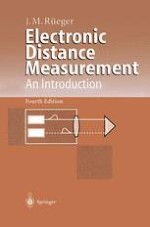
1996 | OriginalPaper | Buchkapitel
History
verfasst von : Dr. J. M. Rüeger
Erschienen in: Electronic Distance Measurement
Verlag: Springer Berlin Heidelberg
Enthalten in: Professional Book Archive
Aktivieren Sie unsere intelligente Suche, um passende Fachinhalte oder Patente zu finden.
Wählen Sie Textabschnitte aus um mit Künstlicher Intelligenz passenden Patente zu finden. powered by
Markieren Sie Textabschnitte, um KI-gestützt weitere passende Inhalte zu finden. powered by
Historically, the development of electro-optical distance meters evolved from techniques used for the determination of the velocity of light. Fizeau determined the velocity of light in 1849 with his famous cogwheel modulator on a line of 17.2 km length: Light passed through the rotating cogwheel, travelled to a mirror at the other end of the line, was reflected and returned to the wheel where the return light was blocked off by the teeth at high revolutions of the wheel. Fizeau’s experiment employed for the first time the principle of distance measurement with modulated light at high frequencies. Later, Foucault employed a rotating mirror in 1862 and Michelson (1927) a rotating prism in 1926 for similar experiments. According to Zetsche (1979), the first electro-optical distance meter was developed by Lebedew, Balakoff and Wafiadi at the Optical Institute of the U.S.S.R. in 1936. In 1940, Hüttel published a technique for the determination of the velocity of light using a Kerr-cell modulator in the transmitter and a phototube in the receiver. This inspired the Swedish Scientist E. Bergstrand to design the first “Geodimeter” (for geodetic distance meter) for the determination of the velocity of light in 1943. The first commercial instrument (Geodimeter NASM-2) was produced by the Swedish company AGA and became available in 1950. With the early Geodimeters, longer distances could only be measured at night. An important development was the introduction of the heterodyne technique to electro-optical distance meters by Bjerhammar in 1954, which enabled the execution of more accurate phase measurements at more convenient low frequencies (Bjerhammar 1971). The first instrument to employ the heterodyne principle was the Geodimeter Model 6A. Subsequently, the principle was employed in distance meters of all makes. The (laser) Geodimeter with the longest range (60 km), the Model 8, was released in 1968. It has been used widely in high order geodetic networks throughout the world.